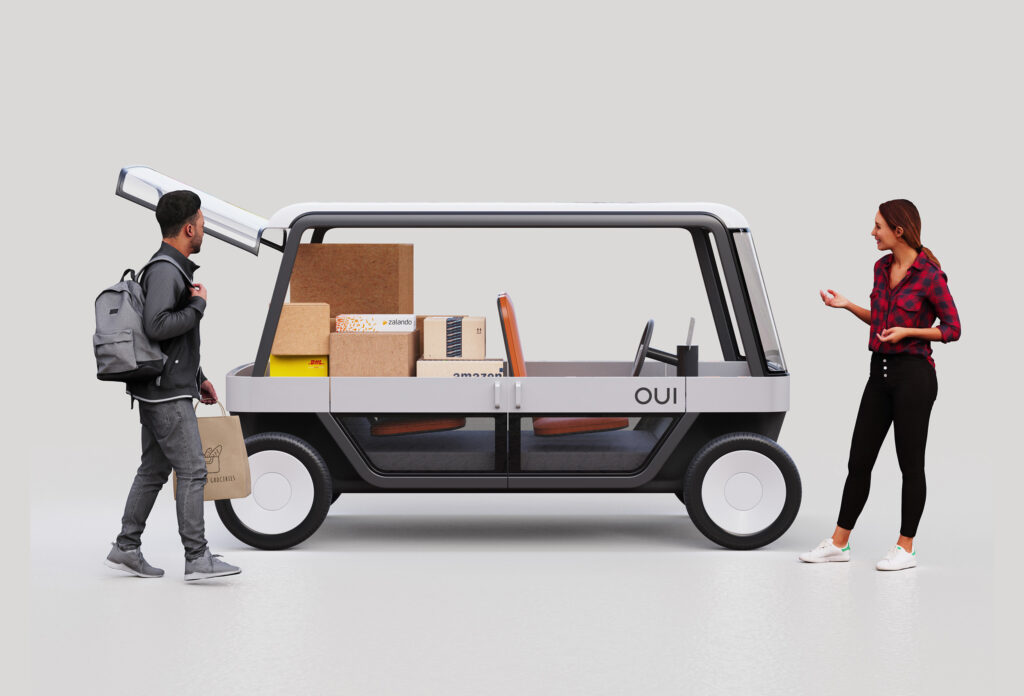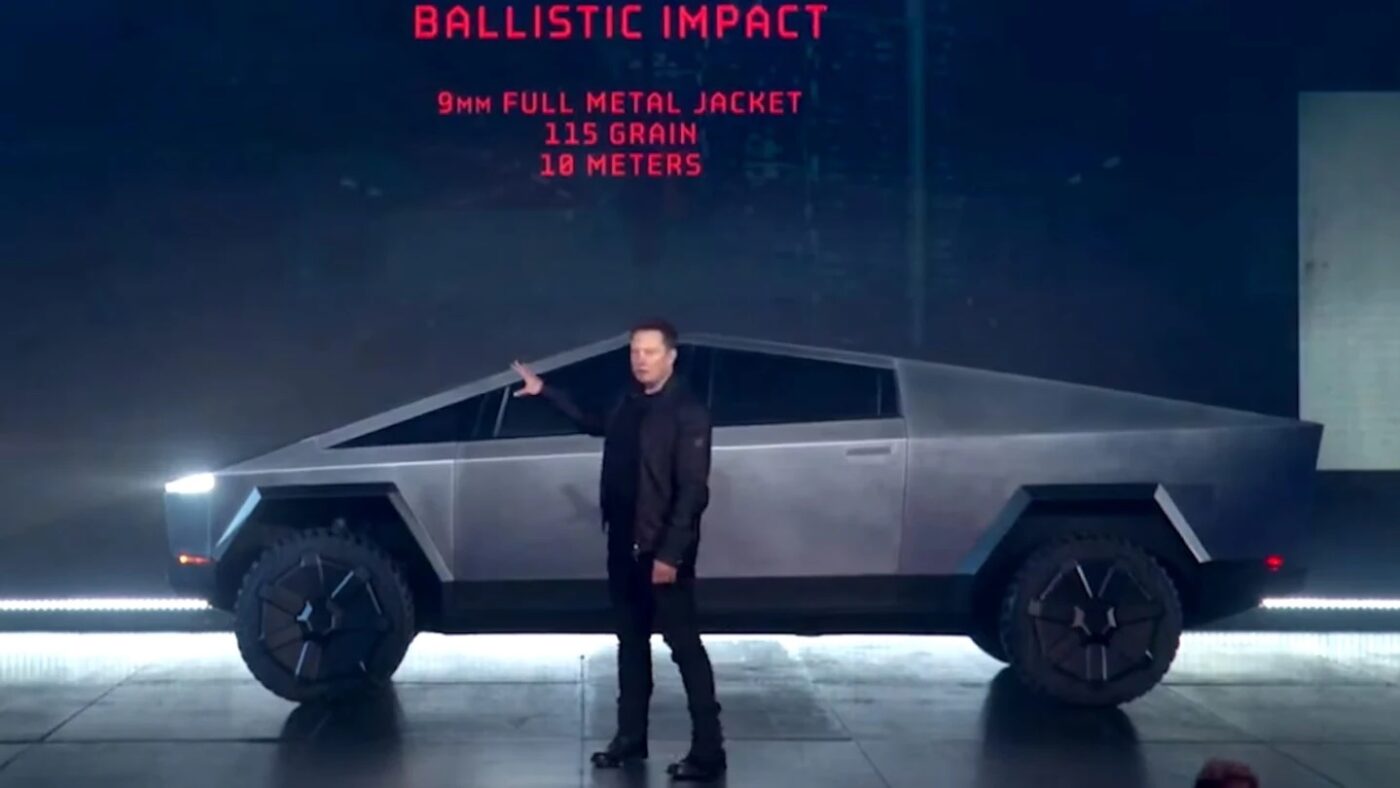
AUSTIN (TX) – November 2019 is the month in which Blade Runner (1982), the stunningly styled dystopian futuristic sci-fi thriller, was set. In a super high density version of Los Angeles. In the actual month of November 2019, Elon Musk, world famous entrepreneur and engineer, revealed his latest creation, the Cybertruck, on a stage near the Space X rocket factory, also in Los Angeles.
The Cybertruck is a futuristic looking electric pickup truck; essentially a big car with a cabin in front and a large open cargo bed in the back for transporting large objects and other stuff. In the US, this type of car has been around since the advent of the mass produced car, but the design of the Cybertruck looks radically different from all the other trucks on the market. Its body is an angular shape consisting entirely out of flat surfaces that are folded like a giant stainless steel origami. The date of its ‘reveal’ was no coincidence; the whole idea of what is futuristic about the car draws its inspiration from Blade Runner.
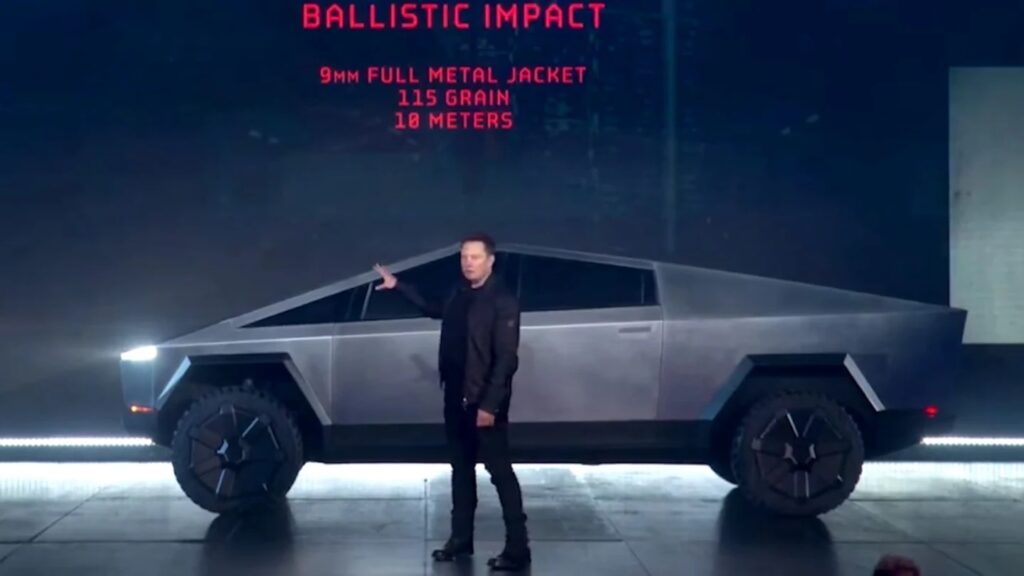
Shortly after the Cybertruck was presented to the world, I received a lot of messages from friends who wrote to me that it looked very similar to a car that I had designed a few years earlier (2011). Existing only on paper and in scale model, my car’s design also consisted of flat surfaces and sharp folds. It looks sort of like a low slung monolithic 3D trapezium on wheels. It is much smaller and lower than the Cybertruck; it’s 3.5 m long compared to the Cybertruck’s 5.8 m and about half the height. The design language is similar, but I can’t claim to be the first to design a car like this. There are many precedents: the Citroen Karin (1980), the Lancia Sibilo (1978) and the Aston Martin Bulldog (1979) for instance. There are a number of architects who contributed to the list; Mario Bellini with his Kar-a-Sutra (1972) and Gio Ponti was well ahead of his time with the Linea Diamante (1953). The Dutch architect and artist John Kormeling cannot go unmentioned here with his Square Car (1982-1994), and my cousin, Rem D Koolhaas, with whom I grew up drawing cars, also designed and built an extremely angular car called the Lo-Res (2013), for low resolution. All of these precedents were concept cars and now, for the first time in history, a car like this is going to be mass produced. This is quite remarkable because car companies, being risk averse, never really dare to put such radical designs on the market.
The most obvious reason for designing a car in the shape of a polyhedron is that it stands out. “It doesn’t look like anything else” is what Elon Musk points out in his presentation. He shows what inspired the design; besides the F117A Stealth Fighter airplane (1983) and the USS Zumwalt Navy Destroyer (2013), there is also an image of Farshid Moussavi’s Museum of Contemporary Art (2012) in Cleveland. Each of the examples is made out of flat surfaces, and regardless of the function of the objects, they all possess a fascinating sculptural quality. They are reminiscent of the monolith in A Space Odyssey (1969); a beautiful mysterious object with awesome destructive powers.
Blade Runner is actually an image of the future that is by now more than forty years old. The original sets, the streets, the city, the taxi’s, and the protagonist’s flying ‘spinner’, were all designed by Syd Mead specifically for the Hollywood production. Originally trained as a car designer, he made a name for himself as a visual futurist. He visualized the future for companies like US Steel and Philips, but mostly worked on science fiction movies as a concept designer. The handmade renderings Syd Mead made for Blade Runner have such a sense of drama, mood and atmosphere, so much detail and style that it is hard to describe. In a Wired article by Brian Rafferty from 2017, William Gibson, the acclaimed science fiction writer, is quoted: “Blade Runner changed the way the world looks and how we look at the world” and he considers it “a true classic,” and finally claiming how it became “our cultural-visual template for the future.” Denis Villeneuve, the director of the 2017 Blade Runner sequel Bladerunner 2049 (2017), wrote a foreword in ‘The Movie Art of Syd Mead, Visual Futurist’ by Syd Mead & Craig Hodgetts and wonders: “Is it normal to feel nostalgia when looking at the visions of a futurist?”
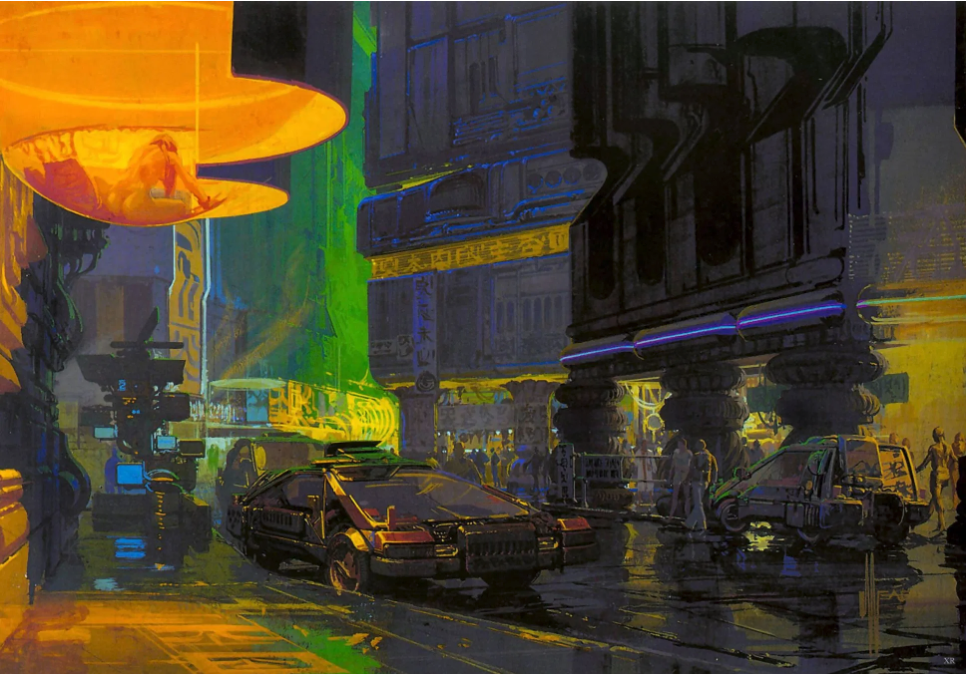
Science inspires science fiction and science fiction inspires science, or ‘tech’ rather. The Cybertruck’s reference to Bladerunner is far from the only reference Elon Musk has made to science fiction; he regularly brings up A Hitchhikers guide to the Galaxy. And he is not the only one in Silicon Valley; Facebook’s parent company Meta gets its name from the ‘Metaverse’, which was coined in the sci-fi novel Snow Crash (1992) by Neal Stephenson. It is cynical that these ‘tech’ companies are using stories meant to warn us of the dangers of technology, as a way to market exactly such potentially dangerous technologies. Inadvertently, such science fiction narratives end up being self-fulfilling prophesies and it becomes harder to imagine the future any other way. Not in the least because there is so much money behind the future as is imagined by Hollywood and Silicon Valley.
I used to call my car the ‘minimal car’. Not anymore. When I was designing it I had the same references in mind as the designers of the Cybertruck. They are a part of the era in which I grew up, the late 80s. They are all ‘cool’ regardless of the story that is behind it. To keep the shape pure and devoid of protrusions and indentations, I explored the possibilities of getting rid of all details; hiding the panel gaps in the folds of the body, replacing the mirrors with cameras hidden behind glass, figuring out how to make the windscreen wiper pop out from under a latch and making the sliding windows appear flush with the rest of the car’s surface. Only the wheels would betray the real function of the abstract object. With a desire to build it myself, I speculated about an aluminum frame made out of extruded profiles and laser cut parts that could be folded into shape. No complex presses and molds would be needed because there would be no curved parts. The logic of a simplified construction gave the basic shape some rationale. But in all honesty the shape came first, rationality after.
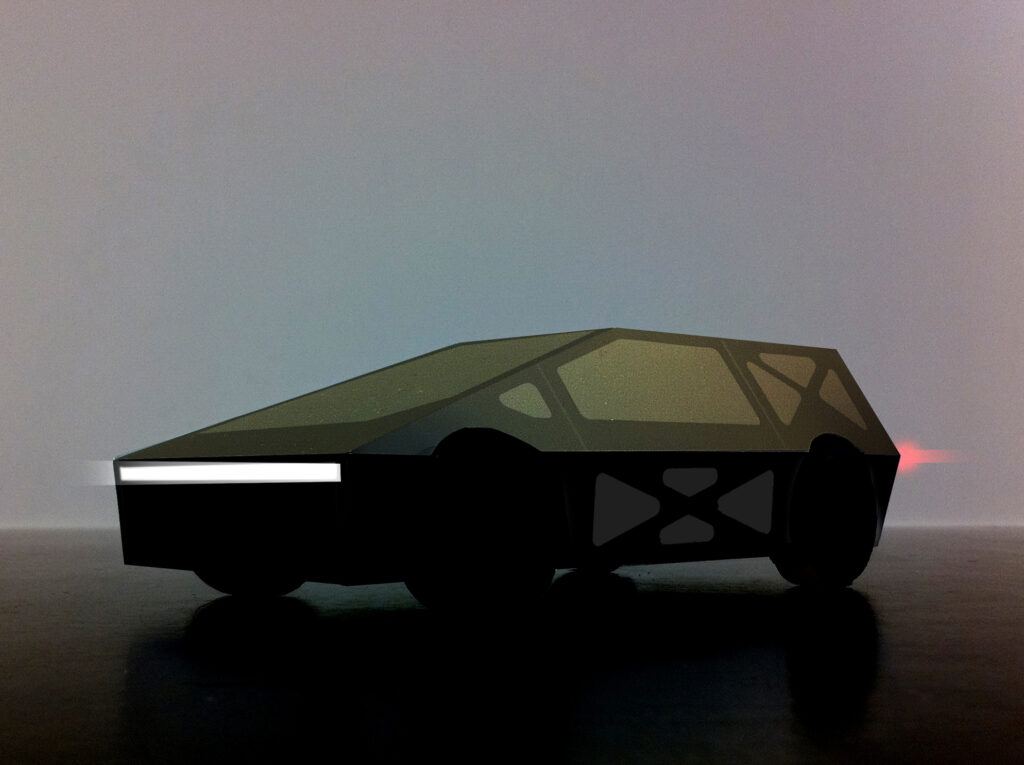
It is actually very hard to make a car with flat panels, as Tesla is evidently finding out. Four years later the world is still anxiously awaiting the Cybertruck’s release. Lacking the inherent rigidity of a curved plane, a flat panel tends to shake and rattle, unless it is stiffened by adding thickness or a secondary construction. For this reason, the panels on the Cybertruck are 3 mm thick. On the average car they are 0.7 mm. Incidentally, this will also stop 9 mm bullets. Bulletproof supposedly being a kind of neat feature on a car whose main selling point is its rough, rugged, and aggressive character. The Cybertruck is literally a tank. Initially, the thick panels were also presented as a kind of ‘exoskeleton’. Although this sounds very innovative, in the actual production model the panels are actually mounted on a ‘unibody’ structure and don’t really contribute to the overall structural integrity, but they do add a lot of weight. 3 mm thick stainless steel panels cannot be pressed the way car panels typically are, they have to be folded. The folding is not so complicated, but getting the folds to align is. This production process not having been done before on a large scale certainly makes it a challenge. But as Elon Musk explains in his presentation; pickup trucks “they all pretty much look the same, and we need something different, and we need sustainable energy now!” Adding, with no sign of irony; “To solve sustainable energy, we have to have a pickup truck!”.
The shape of the Cybertruck, futuristic as it may be, is not very practical. For instance; the sides of the cargo bed slope up to the roof of the car making it hard to access from the side. Another example is the massive front window that requires a windscreen wiper that has been described in an article on The Verge as “comically large”. The same website has an image of the Cybertruck covered in mud showing how the wiper only swipes a limited part of the windscreen; the caption reads “you’re wiping it wrong”. It is this kind of detail that shows that the pursuit for a spectacular form actually creates problems instead of solving them.
A Robb Report article ,“Tesla’s First Cybertruck Is Finally Here” from July 2023, remarks that “Any conversation about the Cybertruck will likely start with its exterior”. Like the monolith in A Space Odyssey, the fascinating form distracts attention away from the danger it embodies. The Cybertruck has awesome power; its numerous electrical motors generate more torque than any other pickup truck. It can easily beat them in a tugging war. The hydraulic suspension allows you to raise the car to drive over rugged terrain, or lower it, to drive it like a sports car on the road. The Cybertruck can do anything, it even stops bullets. The problem is that all of this requires a lot of energy and material resources whilst none of it is really necessary.
Originally the pickup truck was a very practical tool for people like contractors and farmers. Now its prime user is the proverbial ‘soccer mom’. The pickup truck is now mostly used like a ‘normal car’ and like any normal car, it typically carries only 1.5 passengers. With an estimated weight of 3.500 kg that is a ridiculous amount of mass to carry such a small load. Moving this much mass requires a lot of energy. Even though the Cybertruck is electric, the power still has to come from somewhere and most electricity still comes from fossil fuels. The production of the Cybertruck also requires a lot of resources and the mining and processing of raw materials is very damaging to the environment. Using a Cybertruck to pick up kids from school is the equivalent of using a sledgehammer to push in push-pins.
The reason people generally buy a Cybertruck is not because of its practical purpose, but because it is bigger, tougher, stronger and more brutal than the other cars on the road. This is part a choice of lifestyle, part safety. Safe it is, if you are inside of one; but for walkers, cyclists and bikers it is a threat. With the rising popularity of pickup trucks over the past ten years, the number of pedestrian being killed by cars in the US has increased significantly (report by Governors Highway Safety Association). Not quite seeing this as their problem, car makers are more than happy to sell pickup trucks. In a fiercely competitive market there are next to no profit margins on small cars, but the large pick-up trucks bring large profits.
The reason I don’t like to call the car I designed the Minimal Car anymore is because Le Corbusier has already designed a Voiture Minimum (1936). It is nothing against him; it is that I now think my car isn’t really minimal anymore. It was perhaps minimal as a form, but not as an idea. Le Corbusier’s design was really about what is the minimum that a car needs to be; “a minimalist vehicle for maximum functionality.” It was intended as a small, light, simple and practical vehicle affordable for everyone. The design was for a car design competition, which he submitted after the deadline. The complete story of Le Corbusier and the automobile is accurately told in Voiture Minimum; Le Corbusier and the Automobile written by Antonio Amado, MIT press (2011).
We can ask what a minimal car can be, but we should also ask what is the minimum that we need in terms of transport? Do we need to move as much as we do? Could we move around with less weight? Could we walk or cycle? The bicycle is still the most innovative and efficient form of transport mankind has ever produced. In terms of mass and energy required to move a person, it is unrivalled. In terms of the calories used to cover a distance, it is about 5 times more efficient than walking and the energy comes from our food. It keeps you healthy and it takes up very little space. Not everyone can ride a bicycle and there are many scenarios in which something else is more fitting.
There could be a lot more diversity in the types of vehicles that we use, if we wouldn’t sacrifice so much space to the automobile: “The problem is not cars themselves. It is privileging cars over any other form of transport, so that they are not a luxury or an occasional necessity, but rather something we are forced to rely on, day-to-day.” This is what Daniel Knowles writes in Carmageddon; his book on how cars make life worse and what to do about it. What it boils down to, is that innovation is not about bigger, heavier cars. Innovation in mobility is about creating a system that works for everyone. For that, you have to look at transportation and the city as an ecosystem, and in this ecosystem the pickup truck is a dinosaur, the Cybertruck a T Rex; fast, powerful and with very few predators.
“Any line which cannot be justified by its function, does not deserve to be called ‘beautiful’”, declared Gabriel Voisin, the founder of the car brand with his name (he and Le Corbusier were friends). Gabriel Voisin was the 20th century French Elon Musk; but he didn’t build rockets and didn’t fill the sky with satellites, he did, however, build some of the first airplanes. Together with his brother, he set up the world’s first commercial airplane factory. After the first world war he switched to making luxury cars. Apparently because he was traumatized by his creation being used for the purpose of war. Voisin must have had an eye for talent, because he hired André Lefèbvre an aviation engineer who would later work for Citroen where he was instrumental in the development of the Toute Petite Voiture (TPV, 1938), which after further development became the 2CV (1948). The 2CV is a technologically innovative and truly minimalist vehicle with a maximalist functionality. After the second world war, Gabriel Voisin stopped making luxury cars and presented a minimal car he called the Biscooter (1949). The scarcity of materials in the second world war is what motivated Voisin to design it. It only caught on in Spain where it was called the Biscuter. Because it was small, simple and cheap, it was well suited for the crippled economy under Franco. It had a simple construction using aluminum panels. It had a tiny engine and it didn’t go fast at all. It did have the advantage that a driver’s license was not required. It is perfect for getting groceries and other things in case you can’t use a bicycle.
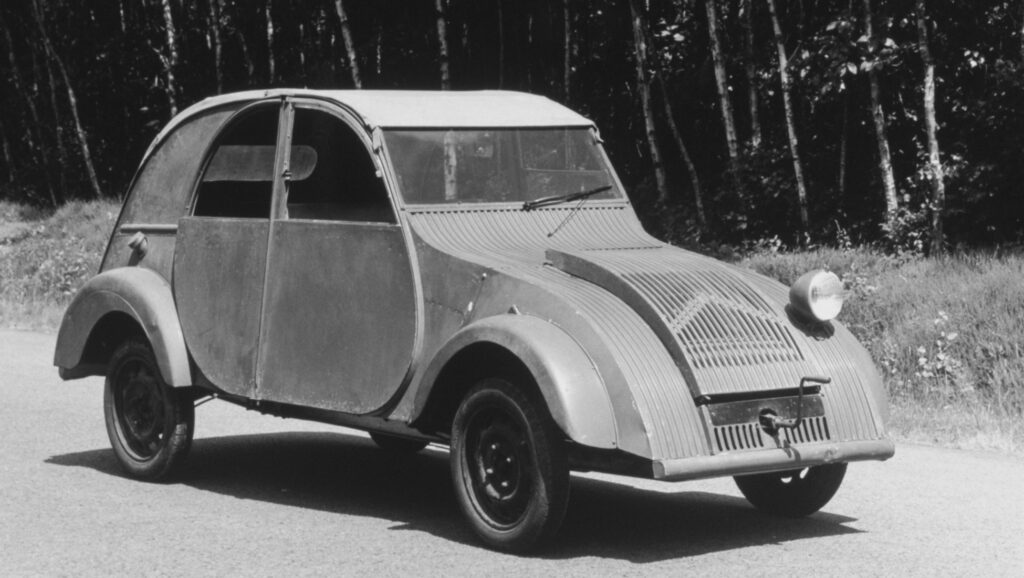
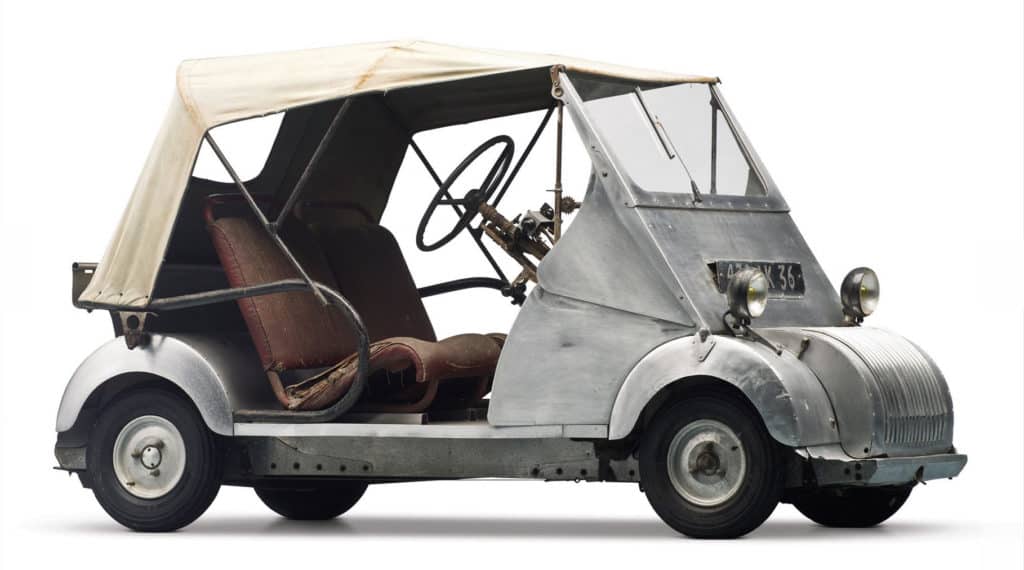
“If technology is the answer, what was the question?” The architect Cedric Price asked his audience in a lecture in 1966. The automobile has long surpassed its functional purpose. It is more about status than about transport. Because we cannot imagine life without it, we will naturally resist the demotion of the automobile. But perhaps we should put more effort in visualizing a future with less and smaller cars? What if Hollywood was to get involved? Syd Mead died shortly after the reveal of the Cybertruck, but there are surely other visual futurists who can do a better job than the urban planners and architects who are currently rendering so called eco-cities. In a way, these renderings are a bit like pick-up trucks in that they all look the same; everything is green, shiny and perfect, everyone is happy, there are no problems. What all of these green eco-city images lack is a plot.
It could be an exciting movie, possibly set in Los Angeles around 2030. Imagine some invasive technology, X, or anything, getting completely out of hand. Toxic air and water, combined with extreme heat causes massive unrest and entire populations have had to relocate. Resources are incredibly scarce and people everywhere have joined in a collective effort to grow plants wherever they can, in order to clean the air, mitigate the heat, and absorb water into the soil. In the movie, the green city looks beautiful and serene, but below the surface it is incredibly dangerous. It is kill or be killed. The protagonist, a low level criminal (could be an architect or engineer) is hired by a rich client to do something dangerous and shady. He is torn between doing the right thing and supporting his family. You have to imagine all the details. What is his house like? How does he get around? How does he bring his kids to school? Do they even go to school? Will he manage to solve his problems? How does it end?
There will probably be a sequel.
